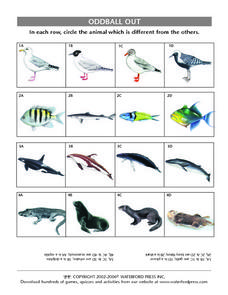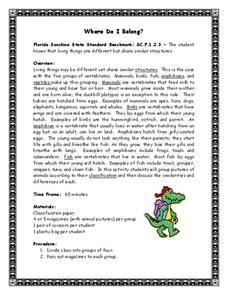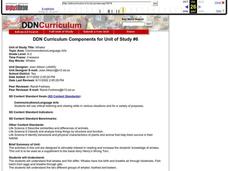Curated OER
Oddball Out: Birds, Fishes, Marine Mammals
In this science worksheet, pupils analyze 4 animal pictures in a row. Students circle the animal which is different from the others. There are 4 rows of pictures. Answers are provided upside down at the bottom of the page.
National Wildlife Federation
Planning Your Research
Make it a great proposal! Class members play the role of marine scientists and choose from a variety of whales considered endangered they would like to study. Scholars then create applications for permits to conduct research of the...
University of Minnesota
Brain Zoo
Who doesn't love a day at the zoo? Use an observation and inference lab to get young anatomists to recognize similarities between mammalian species based on brain structures. You provide the brains; this lesson provides set-up...
Curated OER
Crossword Puzzle- Mammals
In this science crossword puzzle worksheet, young scholars use 11 clues and animal pictures at the bottom of the page to complete the puzzle which is located at the top. They check their answers with the solution given in the bottom...
Curated OER
What is the Evidence for Evolution?
Learners identify one object that would tell the story of their lives. In groups, they determine what can and cannot be told from objects left behind. After watching a video, they compare and contrast chicken bones to human bones. To...
Curated OER
Where Do I Belong?
Fourth graders work in groups. They are given magazines. Students cut pictures of five mamals, five birds, five reptiles, five amphibians, and five fish. They place the pictures in a plastic bag. Students switch bags. They are explained...
Curated OER
Maine Black Bear Research and Field Study Activity
Young scholars participate in a field study of Maine Black Bears. They first do academic research on the Maine Black Bear. Following extensive research and discussion, students go out into the field with Maine State Biologist to observe...
Curated OER
Classification of Intertidal Organisma
Students categorize animals. In this animal classification lesson plan, students group animals by their characteristics. Students break into groups and work together to classify the animals. Students fill out a graphic organizer with...
Curated OER
Whales
Students compare the differences between whales and fish. They examine the differences of toothed and baleen whales. They identify behavioral and physical characteristics of animals that help them survive in their habitat.
Curated OER
Phylum Chordata
All major groups of vertebrates are summarized here with the characteristics of each explained. Other subphyla of chordates are listed: cephalochordata, urochordata, monotremata, marsupialia. The details are relevant but are not linked...
Curated OER
Animals Galore
A well-designed lesson which covers the characteristics of the animals found in the six animal groups is here for your young biologists. In it, learners divide up into six groups; the amphibians, reptiles, mammals, birds, fish, and...
Curated OER
Bats
Use Stellaluna by Janell Canon to discuss bats and other types of animals. Learners identify the differences between bats and birds, list the traits of mammals, create a Bat Facts game, and go on a written scavenger hunt. Fun, clever ideas!
PBS
Population Simulation with M&M's
Math and M&Ms® go great together when introducing a modeling activity. Allow your learners to simulate population growth and decay of fish in a pond and share their reasoning for the change in fish. With such an impact we have on our...
Curated OER
Puppets
Fifth graders explore the art of puppetry. They design and create their own puppets using helium balloons. They create the three dimensional features for their selected mammals and felt shirts. They perform an impromptu play citing...
Curated OER
How Sweat Glands Cool Your Body
Students use water and rubbing alcohol to explain how sweat cools mammals' bodies. They write their findings in a journal. After a lecture/demo, students perform a simple experiment that demonstrates this phenomenae.
Curated OER
Shadow Know-How: Marine Animals
In this fill in the blank worksheet, students identify the names of ten marine mammals by analyzing their outlines in shadow pictures.
Curated OER
Shadow Know-How
In this fill in the blank worksheet, students identify the names of ten different marine mammals by analyzing their outlines in shadow
pictures.
Curated OER
Name Match
In this name match worksheet, students match up fourteen North American mammals to their formal names by drawing a line from one to the other.
Curated OER
Color Me
In this color me worksheet, young scholars color and illustrate four common African mammals: Thomson's Gazelle, giraffe and zebra and Patas monkey.
Curated OER
Color Me
In this color me worksheet, students color and illustrate four urban mammals: red fox, white-tailed deer, eastern gray squirrel and eastern cottontail.
Curated OER
Color Me
In this color me worksheet, learners color and illustrate four Australian and Tasmanian mammals: red kangaroo, numbat, little red flying-fox and Tasmanian devil.
Curated OER
Connect the Dots
In this connect the dot worksheet, students connect the dots to reveal a flying mammal that uses radar-like echolocation to find its way around in the dark.
Curated OER
Orca United Nations
Students study the differences between sets of data and explain how organisms are adapted to their environment. In this marine mammals lesson students analyze data based on set criteria.
Curated OER
Mammal Morphology - Bats, People, and Other
In this physical characteristics worksheet, students compare bats and humans by putting a + sign in the chart for whether or not bats and humans have the same characteristics. Students do this for 17 characteristics and answer 3 questions.
Other popular searches
- Ocean Mammals
- Characteristics of Mammals
- Marine Mammals
- Mammals and Fish
- Animals Mammals
- Land Mammals
- Mammals (Wildlife)
- Prehistoric Mammals
- Mammals Word Search
- Mammals Crossword
- Sea Mammals
- Ocean Mammals 1st Grade

























